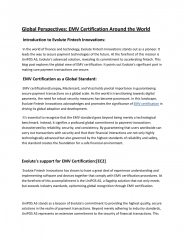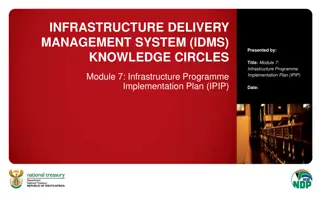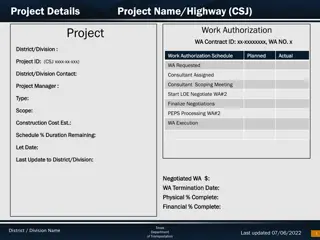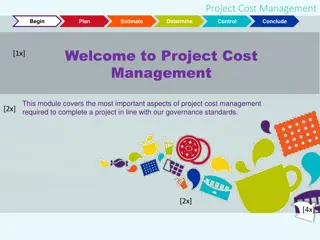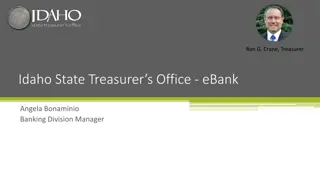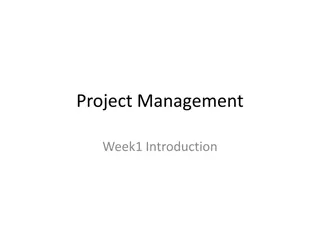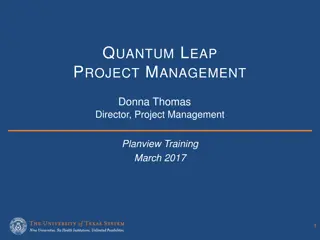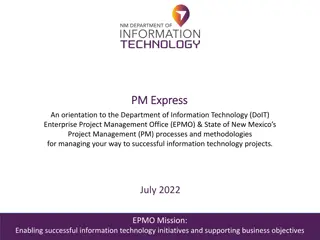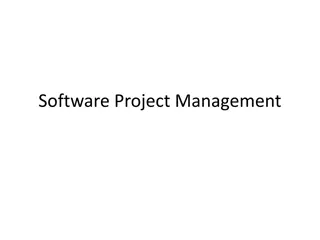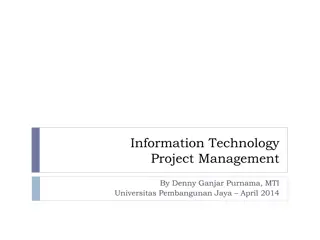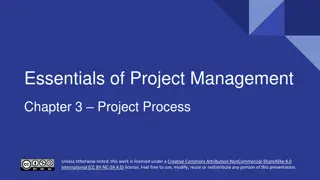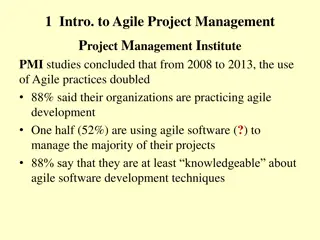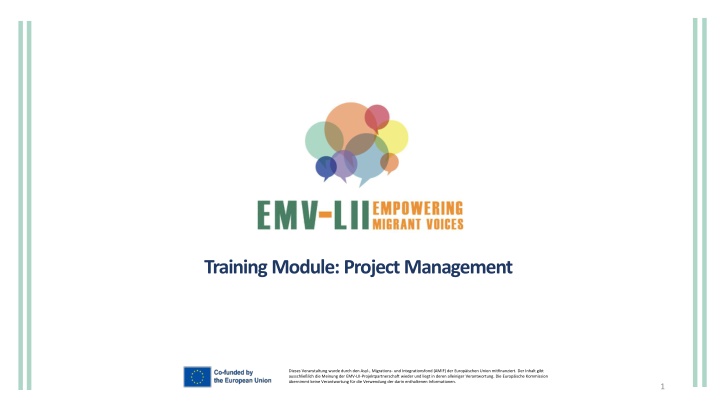
Methods of Project Development and Management Training Overview
Gain insights into project development methods, project management practices, and practical tools in this training module supported by the European Union's AMIF. Explore project planning, problem analysis, stakeholder engagement, and more. Elevate your project management skills with this comprehensive training session.
Download Presentation

Please find below an Image/Link to download the presentation.
The content on the website is provided AS IS for your information and personal use only. It may not be sold, licensed, or shared on other websites without obtaining consent from the author. If you encounter any issues during the download, it is possible that the publisher has removed the file from their server.
You are allowed to download the files provided on this website for personal or commercial use, subject to the condition that they are used lawfully. All files are the property of their respective owners.
The content on the website is provided AS IS for your information and personal use only. It may not be sold, licensed, or shared on other websites without obtaining consent from the author.
E N D
Presentation Transcript
Training Module: Project Management Dieses Veranstaltung wurde durch den Asyl-, Migrations- und Integrationsfond (AMIF) der Europ ischen Union mitfinanziert. Der Inhalt gibt ausschlie lich die Meinung der EMV-LII-Projektpartnerschaft wieder und liegt in deren alleiniger Verantwortung. Die Europ ische Kommission bernimmt keine Verantwortung f r die Verwendung der darin enthaltenen Informationen. 1
Training Objectives Obtain an overview of methods of project development Gain a deeper understanding of project management Learn about practical tools and methods Dieses Veranstaltung wurde durch den Asyl-, Migrations- und Integrationsfond (AMIF) der Europ ischen Union mitfinanziert. Der Inhalt gibt ausschlie lich die Meinung der EMV-LII-Projektpartnerschaft wieder und liegt in deren alleiniger Verantwortung. Die Europ ische Kommission bernimmt keine Verantwortung f r die Verwendung der darin enthaltenen Informationen. 2
IntroductionandCheck-In Hi, my name is .. When it comes to project management, we are particularly interested in .. When you finished this training, what would you like to take with you? 3
Agenda 1. Project development: turning your idea into a project 2. How do I write a project proposal? 3. Project Management 4
1. Project Development Whatisa project? A clearly defined goal A project is characterised by: Limited Resources Innovation Limitation of Time Singularity Complexity 6
1. Project Development A project application reflects the planning process and is guided by the following questions: Situation analysis Problem description Target group(s) Effects Indicators Project activities and achievements Sustainability Cost and financing/expenditure and income plan Source: https://www.nord-sued- bruecken.de/foerderung/foerderprogramme/in-sdg.html 7
1. Project Development Possible Steps in the Planning Process: 5. Definition of Indicators 4. Effect Analysis 3. Strategic Analysis 2. Problem Analysis 1. Stakeholder Analysis Source: https://www.nord-sued- bruecken.de/foerderung/foerderprogramme/in-sdg.html 8
1. Project Development Stakeholder Analysis Identify individuals, groups, governmental and non-governmental institutions, companies, etc. that may be affected by the project. The stakeholders are all related to the project affected or involved, directly or indirectly, positively or negatively. 9
1. Project Development Problem Analysis provides better insight into the existing situation and the influence of the social environment on those involved; is based on the knowledge and viewpoints of those involved; is sometimes based on the creation of a problem tree, which has emerged during participatory workshops and captures and maps the respective priorities of the stakeholders. 10
1. Project Development Strategic Analysis Analysing alternative solutions that could contribute to the achievement of the objective; Evaluating the respective merits of the approaches; Selecting the best strategy based on criteria. These are agreed upon by the representatives of the stakeholders directly involved. Source: https://www.nord-sued- bruecken.de/foerderung/foerderprogramme/in-sdg.html 11
1. Project Development Effect Analysis Possible criteria: Urgency of the situation Relevance for the targeted group Social aspects Existing knowledge and possibilities (in regard to the targeted group) Existing financial resources and expertise etc. Complementarity to other projects Adds to present challenges or contributes to decreasing inequality (e.g. gender equality) Relevancy for partner countries, the EU or other international entities Source: https://www.nord-sued- bruecken.de/foerderung/foerderprogramme/in-sdg.html 12
1. Project Development Effect Analysis Effects are changes in a state as a result of an intervention. They can be endogenous and non-endogenous, expected or unexpected, positive or negative. They occur from the first moment of the intervention, during the entire project duration and in very different areas. Effects are the result of social interactions. Source: https://www.nord-sued- bruecken.de/foerderung/foerderprogramme/in-sdg.html 13
1. Project Development Definition of Indicators Indicators are parameters that have been selected to illustrate a specific, often not directly measurable and complex issue. They say what a change can be observed or measured by (yardsticks). Quantitative indicators with a performance value: XY percent of those trained have found a job Qualitative indicators with a performance value: XY say they have found a better job Source: https://www.nord-sued- bruecken.de/foerderung/foerderprogramme/in-sdg.html 14
1. Project Development Definition of Indicators What information should an indicator contain? Subject reference: Who? (e.g. target group) Spatial reference: Where? (e.g. region) Time reference: When/ how long? Quality: How good/ which criterion is changing? Quantity: How much/ how many? Source: https://www.nord-sued- bruecken.de/foerderung/foerderprogramme/in-sdg.html 15
1. Project Development Definition of Indicators Indicators must be SMART: Specific: specific in terms of quality and quantity; Measurable: measurable with reasonable effort; Available: available from existing source; Relevant: important for what they are supposed to measure and in relation to the project logic (type of indicator); Timely: timely, useful in a reasonable time for project management. Source: https://www.nord-sued- bruecken.de/foerderung/foerderprogramme/in-sdg.html 16
1. Project Development Definition of Indicators: Ways to develop indicators 4. Describe qualitatively 1. Measure or count 2. Scale 3. Classify Exact numbers Example: count participants, indicate number of participants Gradable description Example: Scale the frequency of diseases: always - often - sometimes - rarely - never Non-gradable characteristics Example: YES or NO: Do you have the right to vote in your country of residence?" Exemplary description in words only Example: : simply describe in words what is important in the context of this indicator: "A group of women from neighbourhood X in M. have started baking doughnuts from soy flour to sell in neighbourhood Y". Source: https://www.nord-sued- bruecken.de/foerderung/foerderprogramme/in-sdg.html 17
2. Howtowritea projectproposal A good project proposal is a prerequisite Requirementsofa projectproposal for the approval of a project. However, a good project proposal does not Funding requirements are met Submitted on time Complete application (current forms used?) All questions have been answered Guidelines have been followed The Application is clear, concise and comprehensible The Application is based on facts The Application logic is respected (e.g.: no description of project activities when it is about problem analysis) Cost plan reflects project activities guarantee a good project. Source: https://www.nord-sued- bruecken.de/foerderung/foerderprogramme/in-sdg.html 19
2. Howtowritea projectproposal Dos and Don ts in the writing of a project proposal: Do Include essential contents, methods and didactic concepts or include them as examples. Do so even if things are not always fixed and can change. Follow the "logical" structure of an application, without "telling" and repeating the project idea. Be careful not to write about objectives and methods in the problem analysis part. Follow the structure and do not describe the measures in epic breadth when describing the targeted group! Focus on the project goal but do not make the mistake of describing too many and very different goals that are unrealistic! Source: https://www.nord-sued- bruecken.de/foerderung/foerderprogramme/in-sdg.html 20
2. Howtowritea projectproposal Dos and Don ts in the writing of a project proposal: Don t ...assume that donors or people who decide on projects know the association, the work and the concrete projects. Remember to describe your organisation and the project in a comprehensible way. ...put items, products or entire activities in the cost plan that are not even described or mentioned in the application. Especially with the sometimes quite useful documentation of the project, it is assumed that this does not need to be explained further. Source: https://www.nord-sued- bruecken.de/foerderung/foerderprogramme/in-sdg.html 21
3. Project Management Project Phases Planning Review First project draft Monitoring Controlling Detailed project draft Stakeholder analysis Needs analysis Impact orientation Evaluation Start Implementation Completion Source: https://www.vamos-akademie.de/wp- content/uploads/2021/03/Arbeitsblatt_Detaillierte-Projektplanung.pdf 23
3. Project Management A good project: content criteria - project implementation Content criteria - Evaluation Transparency of funding flows and project planning Monitoring and accompanying evaluation Compliance with procurement rules Personnel: recruitment/payment/gender/respect for workers' rights Flexibility: adapting project strategy if conditions change Evaluation Internal evaluation External evaluation Analysis of the evaluation results Lessons learned The Basis for further projects Source: https://www.nord-sued- bruecken.de/foerderung/foerderprogramme/in-sdg.html 24
3. Project Management Meaningful and successful project management... consists of three phases/components: planning, implementation and evaluation; sees planning as a participatory process of shared understanding and agreement; focuses equally on impact and process; consists of defined phases; is open in terms of methods and tools; and includes cyclical feedback loops throughout the process. Source: https://www.nord-sued- bruecken.de/foerderung/foerderprogramme/in-sdg.html 25
3. Project Management Cost items Cost plan: contains all costs including administrative costs The cost plan should reflect the measures applied for explain larger cost items in the application text Composition/amount of costs should be recognisable. > if possible defined in units (e.g. 10 teaching units 90 min. 100 = 1.000,00 ) Source: https://www.nord-sued- bruecken.de/foerderung/foerderprogramme/in-sdg.html 26
3. Project Management Accounting Should be considered from the beginning! Consists of content and financial accounting. Source: https://www.nord-sued- bruecken.de/foerderung/foerderprogramme/in-sdg.html 27
3. Project Management Case Report 1. Situation description/problem description 2. Target groups 3. Effects/project objectives 4. Indicators (qualitative and quantitative) 5. Description and explanation of project activities 6. Cross-cutting issues 7. Sustainability 8. Cost and financing plan 9. Final evaluation (conclusion, consequences) Source: https://www.nord-sued- bruecken.de/foerderung/foerderprogramme/in-sdg.html 28
3. Project Management Financial Report Simple/complete proof of use Consists of voucher list, cost plan, financing plan (detailed overview of all expenses and income of the project). Accounting by project/cost centre (personnel costs, fees, travel costs, accommodation/food, material costs, administrative costs) No payment without receipt Observe time limits (budget year) Check donors for economic efficiency, proportionality and plausibility Source: https://www.nord-sued- bruecken.de/foerderung/foerderprogramme/in-sdg.html 29
3. Project Management Target/ Actual Comparison of Costs Cost estimates must be available upon request (public procurement law: from 500 -1,000 , comprehensible price Last confirmed cost and financing plan in debit calculation with three companies, from with reduced project costs: 1,000 , three written offers) (Example Germany). Administrative costs decrease in percentage terms Funding amount decreases in percentage Enclose receipts (depending on the funding agency) - Reconciliation/reference to receipts in the progress report Source: https://www.nord-sued- bruecken.de/foerderung/foerderprogramme/in-sdg.html 30
3. Project Management More Tips Charged costs must reflect the content of the project. Check whether all costs are eligible (travel expenses abroad) Verifiable fee scales must be taken into account (BAk V rates). Justify deviations of >20% and apply for reclassification/approval with financial statement. Adjust Cofinancing in time if third-party funds are not approved Totals of cost and financing plan must match. Settle accounts on time or apply for extension in time. Source: https://www.nord-sued- bruecken.de/foerderung/foerderprogramme/in-sdg.html 31
3. Project Management Equality Capital All funds available to the NGO (not earmarked for projects approved by other donors) Project-related donations are regarded as external funds by individual donors. Donations, sponsorship income, reserves from association assets. Revenues from the implementation of the project generally to be used to finance the project, e.g. entrance fees, sales proceeds, participant contributions. Source: https://www.nord-sued- bruecken.de/foerderung/foerderprogramme/in-sdg.html 32
3. Project Management Valorised Services Valorisation of services = valorisation of labour services without real cash flow Show the value of voluntary work contributions from third parties free of charge (e.g. infrastructure such as technical equipment, meeting rooms and/or e.g. accommodation and catering). Can sometimes be counted as own resources (see funding guidelines for each country/budget line). Source: https://www.nord-sued- bruecken.de/foerderung/foerderprogramme/in-sdg.html 33

